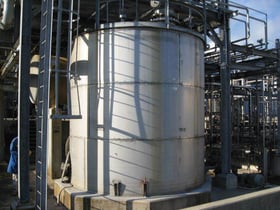Are Stainless Steel Tanks the Best Choice to Store Caustic Soda Outdoors?
Sodium hydroxide (NaOH), also known as caustic soda or lye, is a common inorganic compound that is typically used as a strong chemical base. Sodium hydroxide is used to manufacture soaps, rayon, paper, explosives, dyestuffs, and petroleum products. It is also used in processing cotton fabric, laundering and bleaching, metal cleaning and processing, oxide coating, electroplating, and electrolytic extracting.

Caustic soda is also used in water treatment for a variety of purposes, including:
- pH adjustment: Sodium hydroxide raises the pH level of water to neutralize acidity.
- Coagulation: Sodium hydroxide acts as a coagulant to remove impurities, such as pathogens, organic matter, and other contaminants.
- Heavy metal removal: Sodium hydroxide helps remove heavy metals from water.
- Precursor to other water treatment chemicals: Sodium hydroxide is used to make sodium hypochlorite, a water disinfectant.
In liquid form, caustic soda becomes “slippery” and tends to find weak points in storage containers and fittings. It can eventually create drips and leaks.
Its corrosive and slippery nature make it tricky to store caustic soda, especially if you need to keep it in liquid form. The chemical begins to crystalize at 54 deg F (at 50% concentration), so it’s important to ensure that your storage tank maintains a temperature of at least 60 deg F. If the chemical begins to turn solid, you will have wasted chemical to dispose of, and a potentially challenging cleanup in your tank, fittings, pumps, sensors, and plumbing.
A heat maintenance kit is essential for any chemical storage tank that will be located outdoors in cooler climates. The heating system usually consists of tank heating pads, a thermostat system, polyurethane foam, and a coat of paint.
The number and size of tank heating pads are determined by several factors, including:
- Size of the tank
- Type of tank
- Required chemical temperature
- Ambient conditions
- Tanks and Extreme Cold
Stainless Steel Tanks for Sodium Hydroxide?

Many facilities use stainless steel tanks to store caustic soda. The benefits of stainless steel are obvious: stainless steel walls are resistant to corrosion, the tanks can be kept outdoors, and heating kits are fairly easy to apply.
However, stainless steel tanks also cost three to four times as much as cross-linked polyethylene (XLPE) tanks. In addition, XLPE tanks provide the same performance as stainless steel, and they can be engineered and delivered much quicker than stainless steel chemical storage tanks can.
Poly Processing’s SAFE-Tank® system provides the same double wall tank system and resistance to corrosion as stainless steel, while providing benefits such as:
- Smaller footprint—our double-wall system eliminates the need for a large concrete berm.
- Lower initial costs—XLPE tanks are a fraction of the cost of steel.
- Lower long-term costs—no concrete berm means less maintenance or repair over the life of your storage system.
- Conservation of lost chemical—if a leak occurs, the double-wall system contains any leaked chemical, preventing loss. This allows your facility to continue using the chemical until the damaged tank can be repaired or replaced.
The SAFE-Tank also works well with a heat maintenance kit, and the double-wall functions as an additional measure against heat loss. Our engineers can work with you to determine the ideal solution to maintain proper temperatures.
XLPE Tanks Are the Best Solution for Storing Caustic Soda
While stainless steel tanks are sometimes the common go-to solution for storing sodium hydroxide above 60 deg F, there is no advantage to stainless steel over XLPE tanks. However, there are drawbacks that add up both in the short term and over time. For many facilities, an XLPE chemical storage tank is the smarter cost effective solution for your business.
Get more information on sodium hydroxide storage — download our Sodium Hydroxide Guide
- January 13, 2025
- Topics: Tank Design and Materials, Chemical Storage
About Poly Processing
Posts By Topic
Tech Talk Podcast Episodes
Subscribe By Email
Recent Posts
- Maximizing Fill Efficiency: Selecting the Optimal Fill Line System
- Chemical Storage Tanks: A Quick Guide for End Users
- Popular Customization Options for Chemical Storage Tanks
- Understanding Flood Zones Under the IBC: Building Requirements and Insurance Implications
- Choosing Between Steel, Polyethylene, and Fiberglass Tanks: What You Need to Know
Tank Configurator

Find the recommended tank and system components for your chemical storage challenge.
Configure a Tank Package








